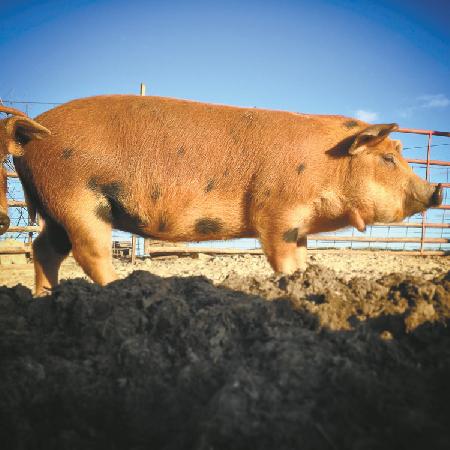 Travis Hood is creating two new hog breeds from "old" stock that he says will taste better than modern breeds and grow faster than heritage breeds. With the help of specialty hog breeder Carl Blake, he is combining old bloodlines in a new way.
Travis Hood is creating two new hog breeds from "old" stock that he says will taste better than modern breeds and grow faster than heritage breeds. With the help of specialty hog breeder Carl Blake, he is combining old bloodlines in a new way.
"We started crossing our bloodlines in early 2015, and we are already seeing positive results," says Hood. "I'm tired of feeding my heritage breed hogs for 8 to 10 months and marketing at 11 1/2 months. I want a hog that will be ready to market at 7 1/2 months or less with 30-lb. hams and well-marbled meat. I want bigger shoulders, a longer loin and larger hams."
Blake, Hood's breeding partner, is looking for the ultimate 110-lb. roasting pig that will be well marbled and ready for market in less than 13 weeks. It will have wide shoulders and a medium-size ham. Fat covering and marbling is a must.
"I want a pig that I can roast with the skin off and the outside layer of fat will caramelize and taste like candy," says Blake.
The two goals are worlds apart in some respects, but both rely on a common breeding base. Hood is using Blake's Swabian Hall breed (Vol. 33, No. 4) derived from a cross of the Chinese Meishan breed and European Wild Boar. He is crossing these with his own Andrus Red Wattle hogs.
Combining the bloodlines will produce a broad genetic base. From that, Hood will select desired traits for each breeding goal. He has picked out the name Kentucky Wattle for his goal. Blake's breed will be selected for characteristics of an old Italian breed called Sienna Gray and called the same.
"It was developed for use as a roasting pig and for charcuterie, cooked, cured and smoked meats like pancetta and prosciutto," says Hood. "They were black with a band of white hair on black pigment skin. They look a bit like a Hampshire on the outside, but very different with more marbling inside."
Hood also wants longer heads on Blake's Sienna Grays. He explains that a delicacy often overlooked in American hogs is the cheek steak found right under the eye. "With most breeds, they are no bigger than a silver dollar, but I am aiming for one that is 4 to 5 in. across," he says.
His Kentucky Wattles will be similar to his current Red Wattle, but more prolific, more productive and as described, mature faster. Part of that faster maturation will allow him to breed females at younger ages, speeding the reproductive process.
He also hopes his new breed will be better mothers than his Red Wattles. He notes that Blake's Swabian Hall are more on the wild side with more mothering instinct, better foraging and housekeeping.
"I want sows with at least 12 viable teats and the ability to wean an average of 12 piglets in 8 weeks," says Hood. "None of my heritage breeds can do that."
He is mixing in a little Hereford blood, another heritage breed he maintains. "Herefords have stronger legs placed out at the corners for more strength," says Hood. "The Red Wattle has relatively weak legs tucked under the body. The Hereford also has a big ham. I don't like their attitude and disposition, but the meat is fantastic."
With his Red Wattles, Hood has found his best marbled meat when the animal reaches about 310 to 330 lbs., usually around 9 months. With the Kentucky Wattle, he is shooting for the same degree of marbling at 245 to 260 lbs. at 6 months.
"They may produce a 3/4-lb. chop instead of 1 1/4, but they'll both fry themselves in a pan with no added grease," says Hood.
According to Hood, what the new Sienna Gray and the Kentucky Wattle will share is deep red, well-marbled meat and wattles. A wattle is kidney-shaped flesh that dangles at the corner of each jowl. While its purpose on pigs is unknown, Hood is using them for external markers of the type of pigs he wants for both breeds.
"Out of 43 piglets born from the various crosses, 42 of them had both wattles," says Hood.
Once some of the hogs are butchered out, he'll see how closely he has met his goals. He expects it will take around about 3 years of selection and rebreeding to define the Sienna Gray and Kentucky Wattle by meat color, marbling and productivity. External characteristics are secondary.
With only one set of second generation pigs on the ground, Hood is excited with what he is seeing. When a young boar developed a hernia, he was castrated and ran with the sows on pasture. Meanwhile his litter mates were in the nearby paddock.
"They had unlimited access to feed, but he matched them in growth with 1/3 the ration," says Hood.
The bad news for wanna-be Kentucky Wattle or Sienna Gray breeders is neither Hood nor Blake intend to sell breeding stock. While that may change in the future, for now they expect to have more market than they can fill.
"When I go to the farmers market, I have a line of people waiting for my pork chops," says Hood. "I can sell out 165 lbs. of pork chops for $10 per pound in under an hour. I need better genetics that will let fewer sows produce more pigs faster to fill the demand."
1-800-834-9665
They're Creating New "Heritage" Hog Breeds
FARM SHOW Magazine » They're Creating New "Heritage" Hog Breeds
They're Creating New "Heritage" Hog Breeds
